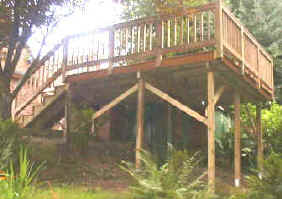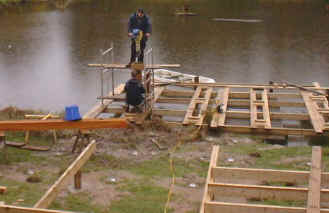|
|
|
|||||
|
|
||||||
|
||||||||||
|
Fast Growing Trees Fastest
Deciduous |
|
Faster
Deciduous |
|
Fast
Deciduous
Evergreen |
|
Fast Growing
Hedging Plants
Deciduous
Evergreen
Arborvitae
Douglas Fir |
Planning a Deck |
Connected pages Patios and decks home | Planning a patio | How to build (lay) a patio | Planning a deck | How to build a deck | Structures |
|
|
Thanks to Decking ideas Ltd. for providing photographs on this page of some of their constructions.
 Simple
decks are probably more suited to DIY
than patios
but your skills
need to extend quite a bit further than putting up shelves. If any part of the
deck is more than 60 cm above ground level, then you need to at least consult a
builder if not call in the professionals to do it all.
Simple
decks are probably more suited to DIY
than patios
but your skills
need to extend quite a bit further than putting up shelves. If any part of the
deck is more than 60 cm above ground level, then you need to at least consult a
builder if not call in the professionals to do it all.
A deck consists of a substantial sub-frame topped with hardwood or softwood decking boards. Unlike patios, even "ground-level" decks are raised at least 6 inches due to the sub-frame.
Decks can be relatively easy to construct on different levels as supporting posts are dug-in and cemented in place with the deck itself fastened to these above ground. There isn't too much digging to do and ground leveling is usually unnecessary. If you do this, make sure that each level of deck gives you a useful and useable area.
![]() Softwood
boards
- These should be pressure treated with a preservative (tannalised)
and ought to
come with a 10 - 15 year guarantee. Do not use untreated timber, even if a
preservative is painted on, it won't get deep enough into the wood.
Softwood
boards
- These should be pressure treated with a preservative (tannalised)
and ought to
come with a 10 - 15 year guarantee. Do not use untreated timber, even if a
preservative is painted on, it won't get deep enough into the wood.
Once
built the deck can be stained almost any color. Don't go too mad though, bright colors, jaunty music and speeded up action may make good television, but living
with bright pinks and yellows long term is a different prospect. Any stain you
paint on the deck is best regarded as cosmetic, it will certainly help preserve
the wood, but it's no substitute for tannalised timber. You will also need to
re-apply any cosmetic stains every so often as it will fade and wear off
particularly in heavily trafficked areas.
Softwood will usually be cheaper than the hardwood alternative, though there is often surprisingly little difference in overall price due to the cost of the sub-frame and labour which are the same whatever boards are laid on top.
![]() Hardwood
boards
- These do not need preserving in the way that softwoods do, though open
end-grain should be sealed where cut. They are frequently darker in color than
softwood. Anyone even considering applying a colored stain to a hardwood deck
should be forced to have their whole house "made over" by
over-enthusiastic publicity seeking interior designers on acid. (In my humble
opinion). The finish of hardwood boards is very clean and high quality, they are
the equivalent of the highest quality patio slabs.
Hardwood
boards
- These do not need preserving in the way that softwoods do, though open
end-grain should be sealed where cut. They are frequently darker in color than
softwood. Anyone even considering applying a colored stain to a hardwood deck
should be forced to have their whole house "made over" by
over-enthusiastic publicity seeking interior designers on acid. (In my humble
opinion). The finish of hardwood boards is very clean and high quality, they are
the equivalent of the highest quality patio slabs.
|
Cheaper |
>>>>>>>> |
More expensive |
|||
| Ground level |
>>>>>>>> |
Elevated / split levels |
|||
| Simple shapes |
>>>>>>>> |
Complex shapes |
|||
| Open area |
>>>>>>>> |
Trees / posts in deck |
|||
| Basic softwood | Quality softwood | Basic hardwood |
Oak, Teak etc. |
||
 Decks
can go where no patio ever could, and this is possibly their
greatest asset. Here a deck is being installed to connect a waterfront
house to the river. Definitely a job for the professionals. Over the water,
proper piles must be sunk to provide a solid foundation for the deck
above. The last thing you want is for the platform to start sinking! Decks
can go where no patio ever could, and this is possibly their
greatest asset. Here a deck is being installed to connect a waterfront
house to the river. Definitely a job for the professionals. Over the water,
proper piles must be sunk to provide a solid foundation for the deck
above. The last thing you want is for the platform to start sinking! |
 Once
the framework of the over-water part is complete, the frame of the shore
portion can be constructed. Once
the framework of the over-water part is complete, the frame of the shore
portion can be constructed.
Note the firmly planted metal brackets (in concrete) used to secure the hefty frame members. The sub-frame is built to similar standards as the floorboards in the upstairs part of a house. |
 The
finished article, and very special it looks too! This shows the true
versatility of decks. Here the deck had been constructed to act as a
landing stage with good sized seating / entertaining areas. Decks can be
used as in this case to make use of space where the ground is sloping and
very uneven. As the deck is supported on above the ground rather than
resting on it, then problems of leveling the ground and possibly building
a retaining wall simply don't arise. The
finished article, and very special it looks too! This shows the true
versatility of decks. Here the deck had been constructed to act as a
landing stage with good sized seating / entertaining areas. Decks can be
used as in this case to make use of space where the ground is sloping and
very uneven. As the deck is supported on above the ground rather than
resting on it, then problems of leveling the ground and possibly building
a retaining wall simply don't arise. |
|
|
|
About us. General queries and emails to |
|
Copyright © Paul Ward 2000 - 2012 |